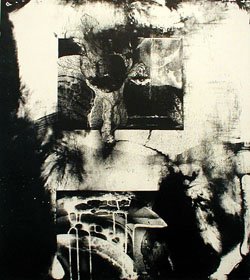
Tiajuana TV
Shelton Walsmith
Shelton Walsmith
Just posted The Vision of God Laughing on The Laughing Bone. I do not believe that it would've been against the wishes of B. Jones, but I do know that he would've considered it of no real value as far as "publishing" it for anyone else. His mirror comment regarding this, that why would anyone care to look into a mirror that was made only for him, as always, got me to thinking about the nature of creating artifacts in general.
I mean, doesn't the fact that an artist feels the need to create something other-than-what-is indicate a fundamental dissatisfaction with what-is? There is, of course, a sort of inherent selfishness in all acts of creation - a desire to mark your passing through the world - whether is be in the form of a child or a painting. I guess the crucial question then is how much your "mark" gives back to the world, adds to it, and increases its value. Would the world have been more or less meaningful without Michelangelo's painting in the Sistine Chapel and with a family of his children?
A priest once remarked to Michelangelo that it was a shame he had never married and produced children to whom he could bequeath his works. "I have too much of a wife in this art of mine, which has afflicted me throughout my life," Michelangelo replied, "and my children shall be the works I leave. What would have become of Lorenzo Ghiberti's reputation if he had not made the gates of San Giovanni? His children and grandchildren sold or squandered all he left, but the gates are still standing."
- G. Vasari, Lives of the Painters

Gates of Paradise, Baptistry of San Giovanni
Lorenzo Ghiberti
Lorenzo Ghiberti
I return to the mirror metaphor. I know without doubt that I cannot see what B. Jones saw in The Vision of God Laughing. However, it is not entirely opaque to me. I do see something that resonates with deeper aspects of my self. Perhaps this is merely the archetypal form that Jones claimed to have stolen from other works. But he, some essential aspect of who he was, is in there also. And this interior richness, resonance, with the created thing is what opens it up; maybe not as a mirror, but at least as a window.
"I was always afraid of mirrors. I had three large mirrors in my room when I was a boy and I felt very acutely afraid of them, because I saw myself in the dim light - I saw myself thrice over, and I was very afraid of the thought that perhaps the three shapes would begin moving by themselves ... I have always been afraid ... of mahogany, of crystals, even of limpid water."
- Borges

Mirror A (Dedicated to Borges)
Michiko Hoshino, lithograph, 1978
Michiko Hoshino, lithograph, 1978